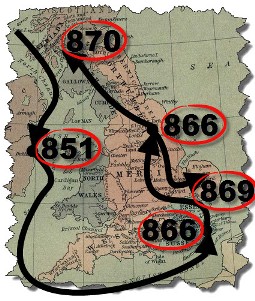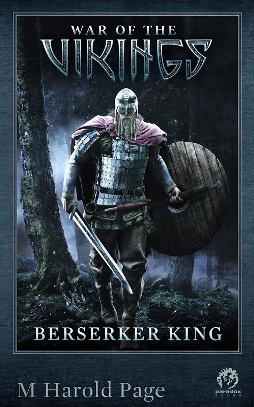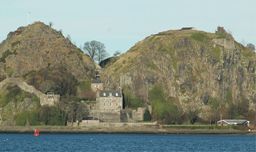Ivar the Boneless; the Dark Age Rommel!

In AD 851, an Arab merchant visited Tang dynasty China, admired the quality of the porcelain, relished its delicate transparency… but enough about civilized folk!
In the same year, in the hairy, sweaty West, Ivar the Boneless sailed in from nowhere with a posse of Viking longships and seized Dublin with the usual mayhem and slaughter.
He didn’t take it from the Irish, because it was founded by Vikings as a base for slaving and trading (usually the same thing). He didn’t take it from the Vikings who founded Dublin, because a previous wave of Vikings had taken it from them.
So Ivar the Boneless claim-jumped the claim jumpers and with his brother Olaf the White settled in to ruling a town that was basically Mos Eisley but with more Thor worship (they had a very nice grove outside the walls) and fewer aliens (unless you count foreign merchants).
“Settling in” meant stomping on everybody else within reach, teaming up with one clan of Irish kings (there were lots of them) to war on an ungodly alliance of established Irish Kings and Viking settlers. The Death Star moment came after fifteen years of war in AD 866, when Ivar’s forces stormed Clonard Monastery. Olaf the White drowned King Conchobar in a handy font and peace broke out.
What happened next makes Ivar the Boneless look like a slow-motion Field Marshal Rommel.

You see, the problem with peace is it’s hard to feed a mega-army of rapacious Vikings without starting another war. Leaving his brother in charge, Ivar stuffed his men into ships — it’s handy to have a major port as a home base! — swept through the Irish Sea, around the south coast of England to its heel, where his brother King Halfdan ruled Kent, one of those little Anglo-Saxon kingdoms more or less erased by the rampaging Vikings.
Kent was handy for invading Wessex, the temptingly rich, but frustratingly well-organised southern kingdom later to be made famous by Alfred the Great and his brother. However, rather than strike West, Ivar struck North into East Anglia.
The saintly King Edmund, ruler of East Anglia, opted to buy off the Vikings and gave them horses in the hope they would go away.
Go away they did, North again, this time on a fantastic 200-mile ride to Eoforwic — modern York — the capital of the kingdom of Northumbria. Northumbria was once rich and powerful, but had descended into a civil war between King Osbert and the self-styled King Aelle.
Eoforwic fell to the Viking horde, got a name change to Jorvik, but kept its Archbishop (Ivar was big on “Under New Management. Business as usual”).
Winter set in. In the spring, King Osbert and King Aelle got their act together and mounted a joint attack on Jorvik. Osbert fell in the fighting. Aelle…
…King Aelle seems to have had his lungs ripped out.
There’s this legend that Aelle had previously executed Ivar’s father Ragnar Hairybreeks by snakepit, and another legend that the Vikings had this sacrificial ritual called the Blood Eagle. I’ll leave the gentle reader to work out the synergy.

The next year found King Ivar reuniting with his brother King Olaf the White far in the north for a joint attack on Dumbarton, the stronghold of the British kingdom of Alcluid.
Dumbarton looks like your kids built it in Minecraft. It’s a massive volcanic rock overlooking the Clyde. It has a sloping cleft in the middle. All you have to do is build a little wall across and you have a perfect fortress. Until the Vikings come, slaughter the warriors and enslave everybody else.
Then, having left a trail of under-kings, now an emperor in all-but-name, King Ivar the Boneless went back to Dublin to live out his twilight years.
He died in his bed in AD873. In noting his death, the Irish chronicles called Ivar “King of Northmen of all Ireland and Britain.”
They also commented that his death welcomed in a forty-year peace.
M Harold Page (www.mharoldpage.com) is a Scottish-based writer and swordsman who just wrote a book with Ivar the Boneless in it. You can get it on Amazon and Steam.
So then I had to google Ragnar Hairybreeks, because seriously, Hairybreeks?
Indeed, Hairybreeks. This is the moment when the illustrious Dave Barry would add, “I am not making this up.”
Which theory about Ivar’s Bonelessness do you subscribe to? I don’t know enough to place a bet, but I do kind of like the idea of Ivar as a Dark Age Miles Vorkosigan.
Well Ragnar needed the hairy trousers to protect himself from the serpents when rescuing the princess, of course. Duh!
Re Ivar – I think the various “Ivar the Disabled Conan” theories are very unlikely because he would have had difficulty surviving childhood. My theory is that he was a wiry bugger who was hard to hit.
Its maybe worth pointing out that Ragnar Hairytrousers is supposedly the inspiration for the main character in the History channel “Vikings” TV series.
Yes. When writing Berserker King, I was careful not to watch that series.
Funny I just read this article today on the 1000th anniversary of the Battle of Clontarf (just outside Dublin), where Viking power in Ireland was finally broken.
Thanks. Very enjoyable.
Glad you liked it. (I hope my admiration for Ivar does not come across as approval.)
Very interesting piece, Harold! It made me all too aware of my ignorance in this regard. You mentioned King Conchobar. It says something about the vagaries of the Irish language that this is actually pronounced ‘Cru-hoor’. Go figure.
> this is actually pronounced ‘Cru-hoor
Are you sure that’s not just the sound he made when Olaf the White ducked him in the font?
I just googled this and there seems to be some fierce and perhaps slightly gonzo debate about Cru-hoor. (http://www.irishgaelictranslator.com/translation/topic34817-20.html)
However, the modern Connor seems acceptable.
I think I’m going to have to agree with the History Channel that “Ragnar Lothbrok” is a better name for the protagonist than “Ragnar Hairypants”. I do highly recommend the show …
I did a kind of Sharpe and focussed on the characters caught up in all this. Ivar features the way Wellington features in the Sharpe novels.